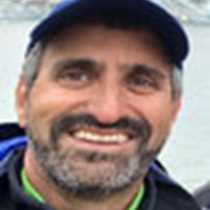Bear Island and the Barents Sea
National Geographic Explorer departed Svalbard’s high arctic archipelago, bearing south through a sun-lightened night halfway across the Barents Sea to anchorage this morning in a protected cove on lonely Bjornøya. Barely on maps, Bear Island, as it translates, is an isolated isosceles of an island in a northern sea rich with marine productivity feeding nesting seabirds, migrating whales and human fisheries.
After our experiences these past days in Svalbard proper observing our planet’s largest and second largest animals (blue whale, fin whale), largest toothed animal (sperm whale), and in particular, largest non-aquatic predator (polar bear), we arrived at Svalbard’s southernmost outpost.
Bear Island was discovered and named by Willem Barents’ Dutch expedition that killed a polar bear here June 1596, hence the name. Bears are rare now in summer, but still follow the southern pack ice edge to Bjornøya as the sea freezes up in winter. Perhaps the lonely isle would be better named Fog Island, given the regular occurrence of dense fog here where the warm influence of the Gulf Stream converges with cold polar currents. At times on Bear Island in the Barents Sea you can barely see for the fog, and bearded naturalists must take bearings by GPS on Zodiac tours of bare rock cliffs full with seabirds.
This morning the wind blew out the fog but strong gusts mixed up a rolling and reflected swell making for exciting Zodiac cruises along Bear Island’s southern cliffs. The sheer walls of slightly metamorphosed seafloor sediments reach 1,300 feet high and are home to thousands of colonially nesting seabirds, particularly tuxedoed guillemots, yakking kittiwakes, and fluttering fulmars which we observed in the air, on the water, and on nests on improbably skimpy ledges. The Zodiac rides in dramatic seas along the dramatic cliffs and in sea caves at Bear Island will not be soon forgotten.
By midday National Geographic Explorer was underway south for the fjords of Norway, which will finally put us back on the map; we have discovered amazing things these past days in regions not usually included in maps of these longitudes.




